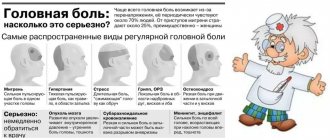Migraine symptoms
Essentially, headaches cannot be measured with instruments or tests. Also, migraine is perceived differently by each person. Headache episodes appear regularly with characteristic symptoms:
- pulsating;
- more often on one side;
- in the area of the eye, forehead, temple.
It may be accompanied by nausea, vomiting, intolerance to bright light and loud sounds. After the attack ends, drowsiness and lethargy may appear. Attacks with the same symptoms are repeated regularly.
During an attack, a person wants to hide from everyone in a dark room, without sharp sounds. He is unable to lead a normal life.
Types of pathology
Migraines are most often classified according to the presence of an aura and its type. The following types of disease are distinguished:
- classic migraine: before an attack of pain, a typical aura occurs with visual, auditory, olfactory and other disturbances;
- migraine without aura: symptoms appear suddenly against a background of relative well-being; the rest of the clinical picture is characteristic of the disease.
Depending on the predominant symptoms, the following types of migraine are distinguished:
- ocular (ophthalmic): accompanied by classic visual impairments: glare, flickering, flare in certain areas of the visual field;
- retinal: the disease manifests itself as complete or partial loss of vision in one eye due to impaired blood circulation in the vessels of the retina;
- ophthalmoplegic: manifested by double vision, visual distortions, drooping of the eyelid;
- basilar: accompanied by dizziness, ringing in the ears, unsteadiness when walking, blurred speech;
- hemiplegic: characterized by loss of sensation and impairment of motor function of one arm or arm and leg on one side;
- cervical: occurs against the background of impaired blood flow in the vertebral arteries and is accompanied by a very severe headache;
- aphasic: pain is accompanied by speech disorders, as with a stroke;
- abdominal: additionally manifests itself as severe pain throughout the abdomen, diarrhea, nausea and vomiting; this form is very common in children;
- “decapitated”: the patient does not feel a headache, as a rule, only visual disturbances are noted, while the prodromal period and aura occur typically.
Migraine status stands apart. This is a severe condition in which two or more attacks occur in a row with less than 4 hours between them. This type also includes pain that lasts for more than 3 days. Against the background of migraine status, the patient experiences repeated vomiting, which does not allow him to eat, drink, or take medications normally.
Attack phases
The migraine attack itself is divided into several phases, during which it develops and then subsides.
Prodromal phase. Characteristic signs are noticeable several hours before the attack. Sometimes this period increases and they appear in 2 days.
You may note irritability, excitability, sensitivity to light and sounds, irresistible food cravings, increased frequency of trips to the toilet, thirst, lethargy, feeling tired, blurred vision, yawning, drowsiness, slurred speech, impaired concentration, general weakness, lack of appetite.
Aura. Lasts from 5 to 60 minutes, characterized by visual, sensory, motor, and speech disorders.
Painful phase of the attack. This phase can occur after the aura or develop in parallel with it. The pain increases from mild, moderate to intense. Although it is unilateral, the side of the pain can change during one attack. Usually appears in the eye area, in the postorbital, frontotemporal zone. Initially, the pain is dull, gradually turns into throbbing, its intensity increases, and eventually becomes constant and severe. The painful part of a migraine attack can last from 4 to 72 hours.
The pain phase can occur after the aura or develop in parallel with it.
Postdromal phase. After the attack subsides, symptoms of weakness, drowsiness, low concentration, and depression may remain for up to 2 days.
The severity and duration of attacks can vary greatly from person to person, as well as from one person to another.
What comes first
Until recently, doctors confidently stated that there are a number of factors that can throw the trigeminal nucleus out of balance and cause another migraine attack. Among such provocateurs are stress, the onset of the menstrual cycle in women, alcohol, certain foods (for example, chocolate), lack or excess of sleep, hunger, and in some cases cold weather.
However, more recently this theory has been questioned. The fact is that a migraine attack consists of several phases. The very first is called the “prodromal period,” when there is no pain yet, but the person is already experiencing certain sensations. For example, drowsiness, cravings for certain foods or, conversely, aversion to food, causeless restlessness and anxiety may appear. Such precursors may appear one or two days or several hours before the onset of an attack.
So, scientists conducted several studies and found that during the prodromal period in migraine patients, a part of the brain - the hypothalamus - is activated. There is a version that it is the excited hypothalamus that triggers the process of activation of the trigeminal nerve nucleus, that is, a migraine attack. Moreover, interestingly, the hypothalamus regulates sleep and wakefulness cycles and is partially responsible for emotions, eating behavior and the production of hormones. Therefore, it is likely that increased activity of the hypothalamus, as it were, pulls migraine provocateurs with it. The chain may look something like this: due to excessive activity of the hypothalamus, a person wants sweets - he eats chocolate - he gets a headache. Or: an excited hypothalamus makes the patient nervous - the patient quarrels with loved ones - a migraine appears. That is, it turns out that chocolate or a quarrel did not lead to a migraine, but arose precisely because the attack had already begun, the patient just doesn’t know about it yet.
Types and possible causes of headaches. Infographics Read more
Psychological characteristics
There is an expression “migraine personality”, it says that there are a number of psychological traits characteristic of people with this problem: ambition, a tendency to demonstrative reactions, a desire from childhood for recognition from others, aggressiveness. They are pedantic, efficient, principled, and strictly follow generally accepted norms of behavior.
Since migraine attacks occur spontaneously and unpredictably, this creates a feeling of apprehension, anxiety, fear and disrupts the usual rhythm of life. These people are sensitive to stress, prone to anxiety-depressive reactions, and emotionally unstable. But thanks to their ambition and motivation, they set significant goals for themselves and usually successfully achieve them.
You can read how to deal with stress during migraines here.
Causes
Most often there is a genetic predisposition and it is transmitted through the maternal line. To do this, it is not necessary that your mother or grandmother suffers from migraines. It could even be a great aunt. But the presence of a genetic predisposition does not immediately lead to the disease; many provoking factors must coincide, which will transform the gene feature into an obvious problem. This means you can reduce your risk by avoiding the following factors:
- high intellectual load without rest;
- heavy physical overload;
- psychological “shake-up” (turbulent emotions, mental stress);
- long work at the computer;
- excessive/insufficient sleep.
Certain foods can provoke new attacks, each with their own (tomatoes, eggs, alcohol). In women, there is a connection between attacks and any hormonal fluctuations: menstruation, pregnancy, lactation, menopause.
Working at a computer for long periods of time can lead to the development of migraines.
Plan ahead
Identifying the triggers of your migraines and planning how to avoid them is an important part of managing the condition. By staying away from such factors, you can avoid the worst symptoms.
If you still cannot get rid of this ailment using the methods described above, you can also try these five natural remedies against migraine.
Share in:
Related Articles:
- Lose weight 3 times faster by adding this spice to your daily diet Everything you should know about carotenoids Five types of tea that will help you get rid of extra pounds Citramon during pregnancy. Can I take it and what can I replace it with?
How to treat migraine
Often, treatment for migraine at home consists of uncontrolled and indiscriminate use of medications to relieve an acute attack of headache. Taking the usual analgin, citramon, aspirin, paracetamol, diclofenac often does not help, and also interferes with an accurate diagnosis and the doctor prescribing the correct treatment. The choice of drug depends on the strength of the symptoms during the attack.
For more than 15 years, drugs from sumatriptan, a class of triptans, have been used:
- Sumamigren;
- Amigrenin;
- Imigran (nasal spray).
It is noted that this drug is more effective if the symptoms increase slowly during the attack. Drugs in this group are specially designed for the treatment of migraines, but they must be selected by a doctor taking into account the individual characteristics of the person.
Pain relief cannot be considered a complete treatment. If attacks occur more than once a month, preventive therapy is necessary.
Various groups of drugs are used to prevent attacks:
- antiepileptic drugs (sodium valproate, topiramate);
- β-blockers (propranolol, metoprolol);
- calcium channel blockers (flunarizine, verapamil);
- antidepressants (amitriptyline);
- riboflavin, magnesium preparations;
- combined non-steroidal drugs.
This treatment helps the body cope with the consequences of attacks - decreased blood flow, malnutrition, oxygen starvation of the brain and reduce inflammatory factors.
Before taking medications, be sure to consult your doctor.
Treatment methods
In most cases, the frequency of migraine attacks can be significantly reduced or their severity reduced. To achieve this, it is important to carry out preventive measures, which can be divided into the following groups of preventive measures:
Controlling the causes of migraine – in this area it is important to adhere to the following rules:- monitor blood sugar levels to prevent them from falling;
- do not consume foods containing thiamine and nitrites (for example, potatoes, sausage, beer, red wine, etc.);
- provide the body with sufficient fluid daily;
- avoid long exposure to the scorching sun, etc.
- Lifestyle change - here it is meant:
- proper nutrition, rich in all the vitamins and microelements the body needs;
- giving up bad habits - smoking, alcohol (read about the effects of alcohol on migraines here);
- reducing the amount of caffeine consumed up to completely eliminating this substance from your diet (you can read about whether you can drink coffee when you have a migraine, as well as learn useful recipes and contraindications here);
- correct sleep mode;
- regular physical activity (but not excessive), etc.
- Taking medications – this group is represented by the following events:
- refusal to take hormonal medications (contraceptives);
- taking medications for preventive purposes (for example, Propranolol, Valproic acid, Topiramate, etc.);
ATTENTION. Medicines should be taken only as prescribed by a doctor. - taking food and herbal supplements. For example, scientists have found that regular intake of magnesium significantly helps people suffering from migraines. However, even here it is better to consult a specialist.









